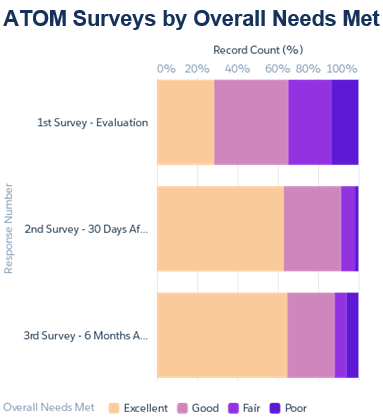There are many
patient-reported outcome measures that gauge the effectiveness of assistive technology interventions in general or wheeled mobility and seating specifically. These measure the interventions from the standpoint of the
client’s opinion of the experience with their equipment. Patient-reported outcomes are an important tool in the field of Complex Rehab Technology (CRT). They can assist in informing clinical and ATP/supplier practice, as well as ultimately assisting in shaping CRT public policy.
In September of 2020, Numotion embarked on the utilization of
The Assistive Technology Outcome Measure (ATOM), an outcome measure specific to the use of a wheeled mobility base. This outcome measure was created and validated by Stephen Sprigle, PhD (and group) of The Georgia Institute of Technology in Atlanta. Dr Sprigle also provides his expertise with the project.
The ATOM “packet” is composed of 3 components: a permission form that must be signed by the client, demographic questions and the ATOM survey itself. The client must be 18 and over and able to communicate, and being evaluated for least their second wheelchair
OR walking unsafely and requires a CRT wheelchair to be safe.
After obtaining written permission from the client, the Numotion ATP/supplier asks the client the questions during the evaluation, taking about 5-10 minutes. The same questions are asked 2 more times, and then compared. The second time is one month after fitting of the equipment so the client has the opportunity to live with the equipment for awhile. The third time is 6 months post-fitting. The follow- up phone calls are made by experienced seating and wheeled mobility therapists.
At this writing there are a total of
618 responses broken down as follows:
- 385 evaluation surveys
- 163 second surveys, one month after fitting (follow-up phone call)
- 70 third surveys 6 months after fitting (follow-up phone call)
As sample graphs show below, aggregates of key indicators in these areas have all been rated as improving or remaining the same between surveys.
One small comparative analysis revolved around telehealth. A small sample of 40 clients (13 in Telehealth and 27 non-Telehealth) submitted 2 ATOM surveys over an 8 -month period. Analysis indicated that there was no association between change in outcomes scores in the Telehealth versus non-Telehealth groups. In the telehealth group, ATOM scores increased in 85% of the clients.
We have just begun to analyze more comparative data in this new project.

Examples of aggregated results thus far:
Overall, how well does this wheelchair (or scooter) meet your needs?
 How safe do you feel safe while propelling or driving your wheelchair (or scooter)?
How safe do you feel safe while propelling or driving your wheelchair (or scooter)?
 How easy is it for you to use your wheelchair (or scooter) within your home?
How easy is it for you to use your wheelchair (or scooter) within your home?

a. Very easy
b. Somewhat easy
c. Somewhat difficult
d. Very difficult
e. I don’t use it in home